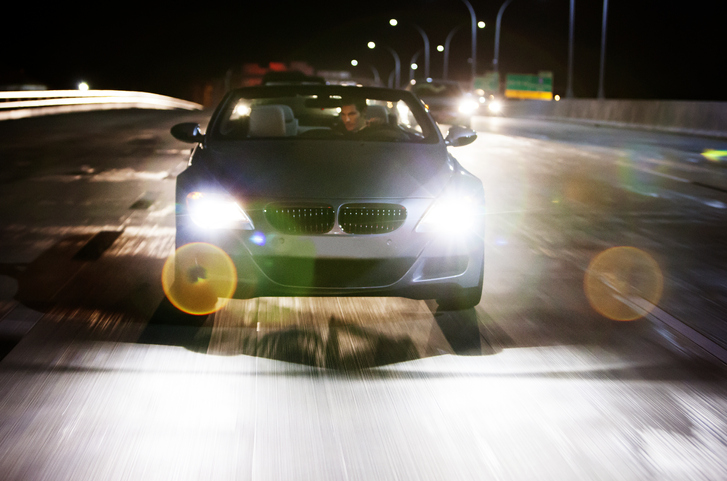 |
| Advise patients on how to minimize distracting visual effects at night, especially while driving. Photo: Getty Images. Click image to enlarge. |
One common problem glaucoma patients often experience is photosensitivity with glare, which makes many daily activities such as driving or spending time outside difficult. Glare manifests as a dazzling sensation in the presence of relatively bright light. It often induces discomfort and can interfere with vision. It’s the result of intraocular light that originates from a bright source scattering, which reduces the contrast of retinal images by spreading a veil of light across them. One study reported that almost 70% of glaucoma patients experience glare-related problems, and another found that more than half of glaucoma patients who drive find that glare makes it challenging.
“Studying and measuring glare disability in the glaucoma patient is important for understanding its influence on activities of daily living and mobility and to help find countermeasures to decrease its consequences for patients,” researchers wrote in a study recently published in the Journal of Glaucoma. “Only two studies [thus far] have evaluated the impact of lighting conditions on mobility in glaucoma. These studies showed difficulties or risks of falling in low-light conditions or high glare areas.”
The researchers evaluated 22 glaucoma patients and 12 age-matched controls in their study, which employed objective measures of glare, as opposed to questionnaires like the previously mentioned studies. Each participant underwent clinical evaluation of visual function and halo size measurement to determine their level of glare disability via a glare score of the best eye (GS-BE) and worse eye (GS-WE). The researchers evaluated mobility with four mobility courses on an artificial street under photopic and mesopic conditions with an additional light source to mimic dazzling conditions.
They found that GS-WE and GS-BE were significantly higher in glaucoma patients than controls. They noted significant differences between moderate glaucoma patients and controls and between severe glaucoma patients and controls.
In the artificial street course, the glaucoma group exhibited significantly different mobility performance, including under mesopic and photopic conditions, mobility time, distance traveled, preferred walking speed, percentage of preferred walking speed and Nasa task load index scores. Glaucoma patients were significantly worse than controls in the low-light situations with regard to walking speed, percentage of preferred walking speed, mobility time and Nasa task load index.
“Our findings reveal significant glare disability for moderate and severe glaucoma patients with a significant impact of glare disability on mobility performance,” the researchers explained. “Evaluation of orientation and mobility courses under mesopic and photopic lighting conditions showed that glaucoma patients’ mobility was significantly altered under conditions of glare. The number of mobility incidents wasn’t statistically different between mesopic and photopic conditions for glaucoma patients. This demonstrates adaptation for glaucoma patients, reducing their speed and modifying their course in order to prevent mobility incidents. This adaptation to glare conditions requires a higher physical and mental workload, as shown by the higher Nasa task load index under mesopic conditions than photopic conditions in the glaucoma group.”
There are several reasons why glaucoma patients may suffer more from glare than healthy patients:
- The macular pigment density may be lower in glaucoma patients. Macular pigment acts as a yellow filter and promotes comfort by reducing glare and dazzle.
- Glaucoma patients may have a reduced density of intrinsically photosensitive retinal ganglion cells (RGCs) or melanopsin-expressing RGCs, which contribute to the maintenance of the pupil diameter and pupillary constriction. A responsive pupil helps to reduce the visual effects of glare, diffraction and other optical aberrations.
- Ocular media changes may induce light scattering. Many open-angle glaucoma patients also have concomitant ocular surface disease or changes in tear film osmolarity.
Currently, there aren’t any effective countermeasures to reduce glare. Colored filters work to some degree, but because they filter targets and glare sources have similar spectra, the filters only work proportionately and don’t increase retinal image contrast. The researchers say that further studies on glare disability are needed and that clinicians should be aware of the glare-related challenges their patients may face.
Bertaud S, Zenouda A, Lombardi M, et al. Glare and mobility performance in glaucoma. J Glaucoma. September 10, 2021. [Epub ahead of print]. |

